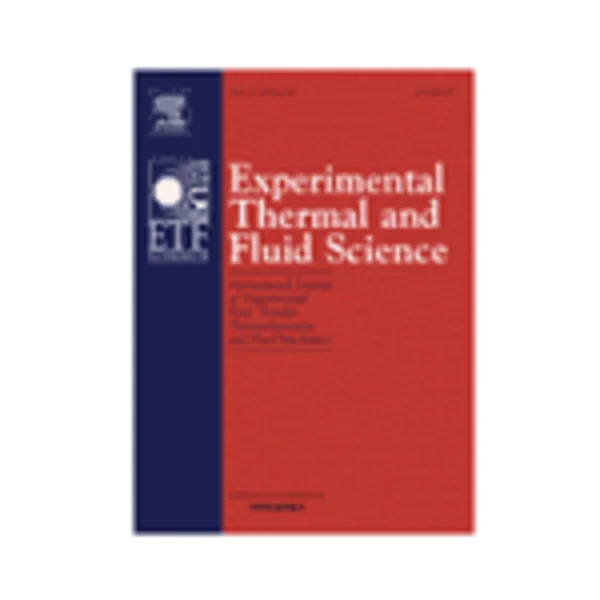-
macro-to-microchannel transition in two-phase flow: part 2 – flow boiling heat transfer and critical heat flux
جزئیات بیشتر مقاله- تاریخ ارائه: 1392/07/24
- تاریخ انتشار در تی پی بین: 1392/07/24
- تعداد بازدید: 1100
- تعداد پرسش و پاسخ ها: 0
- شماره تماس دبیرخانه رویداد: -
this part of the paper presents the current experimental flow boiling heat transfer and chf data acquired for r134a, r236fa and r245fa in single, horizontal channels of 1.03, 2.20 and 3.04 mm diameters over a range of experimental conditions. the aim of this study is to investigate the effects of channel confinement, heat flux, flow pattern, saturation temperature, subcooling and working fluid properties on the two-phase heat transfer and chf. experimentally, it was observed that the flow boiling heat transfer coefficients are a significant function of the type of two-phase flow pattern. furthermore, the monotonically increasing heat transfer coefficients at higher vapor qualities, corresponding to annular flow, signifies convective boiling as the dominant heat transfer mechanism in these small scale channels. the decreasing heat transfer trend at low vapor qualities in the slug flow (coalescing bubble dominated regime) was indicative of thin film evaporation with intermittent dry patch formation and rewetting at these conditions. the coalescing bubble flow heat transfer data were well predicted by the three-zone model when setting the dryout thickness to the measured surface roughness, indicating for the first time a roughness effect on the flow boiling heat transfer coefficient in this regime. the chf data acquired during the experimental campaign indicated the influence of saturation temperature, mass velocity, channel confinement and fluid properties on chf but no influence of inlet subcooling for the conditions tested. when globally comparing the chf values for r134a in the 0.51–3.04 mm diameter channels, a peak in chf peak was observed lying in between the 0.79 (co ≈ 0.99) and 1.03 (co ≈ 0.78) mm channels. a new chf correlation has been proposed involving the confinement number,co that is able to predict chf for r134a, r236fa and r245fa in single-circular channels, rectangular multichannels and split flow rectangular multichannels. in summary, the present flow boiling and chf trends point to a macro-to-microscale transition as indicated by the results presented in ong and thome (2011) [1].
مقالات جدیدترین رویدادها
-
استفاده از تحلیل اهمیت-عملکرد در ارائه الگوی مدیریت خلاقیت سازمانی و ارائه راهکار جهت بهبود
-
بررسی تاثیر ارزش وجوه نقد مازاد بر ساختار سرمایه شرکت های پذیرفته شده در بورس اوراق بهادار تهران
-
بررسی تأثیر سطح افشای ریسک بر قرارداد بدهی شرکت های پذیرفته شده در بورس اوراق بهادار تهران
-
بررسی تأثیر رتبه بندی اعتباری مبتنی بر مدل امتیاز بازار نوظهور بر نقد شوندگی سهام با تأکید بر خصوصی سازی شرکت ها
-
تأثیر آمیخته بازاریابی پوشاک ایرانی بر تصویر ذهنی مشتری پوشاک ایرانی (هاکوپیان)
-
بررسی آموزش مفهوم عدد با تکیه بر کاهش مدرسه هراسی دانش آموزان
-
بررسی تاثیر استفاده از بتن در بهبود رفتار لرزه ای دیوار برشی فولادی
-
معماری سنتی و اماکن مذهبی؛ مهمترین پتانسیل های گردشگری شهرستان رشتخوار
-
مواجهه سازمان ها با چالش های پیش روی توسعه محصولات پیچیده؛ کنکاشی در قابلیت های مورد نیاز جهت ساخت محصولات و سیستم های پیچیده (cops)
-
اثربخشی بازی درمانی با رویکرد شناختی - رفتاری بر سلامت روان و تاب آوری کودکان 5 - 7 سال شهر مشهد
مقالات جدیدترین ژورنال ها
-
مدیریت و بررسی افسردگی دانش آموزان دختر مقطع متوسطه دوم در دروان کرونا در شهرستان دزفول
-
مدیریت و بررسی خرد سیاسی در اندیشه ی فردوسی در ادب ایران
-
واکاوی و مدیریت توصیفی قلمدان(جاکلیدی)ضریح در موزه آستان قدس رضوی
-
بررسی تاثیر خلاقیت، دانش و انگیزه کارکنان بر پیشنهادات نوآورانه کارکنان ( مورد مطالعه: هتل های 3 و 4 ستاره استان کرمان)
-
بررسی تاثیر کیفیت سیستم های اطلاعاتی بر تصمیم گیری موفق در شرکتهای تولیدی استان اصفهان (مورد مطالعه: مدیران شرکتهای تولیدی استان اصفهان)
-
علت یابی افزایش برخی از جرایم و پیشگیری از آن ها در پرتو نظریه یادگیری اجتماعی
-
مقایسه نگرش عشق در زنان بارور و نابارور
-
بررسی تأثیر نقد شوندگی سهام بر مازاد اهرم مالی با توجه به نقش تعدیلگر مالکیت نهادی در شرکتهای پذیرفته شده در بورس اوراق بهادار تهران
-
بررسی تاثیر نقش تعدیلگری مالکیت دولتی، کیفیت حسابرسی و عدم شفافیت شرکت بر رابطه بین سیاست متهورانه مالیاتی و همزمانی قیمت سهام
-
نگاهی موردی بر اشتباه فاحش مدیران ارشد و راه های رسیدن به کمال و موفقیت در کسب و کار




سوال خود را در مورد این مقاله مطرح نمایید :